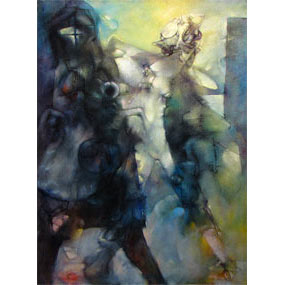
Now nearly a centenarian, the American painter, printmaker, sculptor and writer Dorothea Tanning — a decade younger than Dali, Tanguy and Magritte, and two decades younger than Breton, Miro and Tanning’s husband, Max Ernst — was described by one flippant (and inaccurate) interviewer in 2001 as the “last living Surrealist.” Despite her reluctance to “carry the Surrealist flag,” Tanning makes a prime candidate for the honorific.
In 1936 she was an independent-minded young career woman from Illinois newly arrived in New York and doing fashion illustration for Macy’s while dreaming of painting in Paris; she found herself thunderstruck by the Museum of Modern Art’s “Fantastic Art, Dada and Surrealism” show: “...here, here in the museum is the real explosion, rocking me on my run-over heels. Here is the infinitely faced world I must have been waiting for....signposts so imperious, so laden, so seductive, and, yes, so perverse, that....they would possess me utterly.”
A few years later, her 1942 painting Birthday, a kind of psychological self-portrait as a bare-breasted contemporary Ophelia in a dress of brambles negotiating a maze of doorways accompanied by a small, strange winged quadruped, gained her the attention of the gallerist Julien Levy and future husband Max Ernst. Subsequently, thanks to the importance of being Mrs. Ernst, she also gained entrée to and friendship with the whole expatriate “boatload of madmen,” Duchamp, Breton, Miro, Arp, Balanchine, Man Ray, Miller, Tanguy, Sage, et al. “Beyond the Esplanade: Paintings, Drawings and Prints from 1940 to 1965” presents a sampling of Tanning’s work from the first third of her long peripatetic career in New York, Arizona, and France. Evident throughout are both the stylistic influences of the period and the artist’s ability to absorb and transform them.
On to the works. Beyond the Esplanade (1940) is an early work that demonstrates Tanning’s interest in costume and identity: a young woman in bathing suit sits cross-legged beneath a fancifully beribboned straw hat which also sports branches; she gazes steadily past the viewer with neoclassical composure. Endgame (1944) is a square-format painting depicting a combined chessboard and checkerboard, red and tan squares vying for the parcels not claimed by black, while shadows fall upon the battlefield, a portion of which has been ripped away. A crumpled white lady’s pump tramples a black bishop’s crosier, while heraldic arrangements of rooks and diagrams of chesspiece gambits fill other parts of the board.
Sexual gamesmanship, seen through the metaphor of chess, haunted Duchamp (The King and Queen Traversed by Swift Nudes); Ernst (Capricorn, The King Playing with the Queen), who posed with Tanning for a 1948 photo with the concrete version of Capricorn in Arizona; and Hans Richter, who made a chess-themed film, 8x8, featuring many of the surrealist gang, including Tanning. Fatala (1947) represents Tanning’s dark, figurative style, with girls and young women engaged in mysterious forbidden games. A faceless young woman, all disheveled hair and crumpled brocade, leans against a door, which is also the cover of a huge book, reaching a bony hand through the doorknob hole toward a quartet of chess pawns, one of which is a long-haired female head.
Vorace Veracité (1956), Naufrage en Rose (1958), Untitled (1960), Ignoti nulla Cupido (1960), Matinée Classique (1961) and Deux Mots (1963) represent Tanning’s post-1955 Insomnia period of lyrically colored aqueous/smoky mindspaces in which abstract forms swim and commingle, never quite settling into likenesses. Duchamp, Matta and DeKooning come to mind, but Tanning, if we may risk gender stereotyping and the artist’s disapproval, seems less interested in violence than in metamorphosis. In addition, the wordplay (e.g., Voracious Veracity, Two Words) hints at Tanning’s current focus on poetry.
